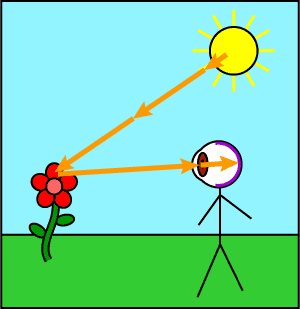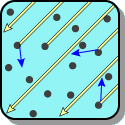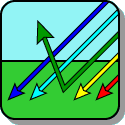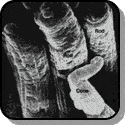From Sun to Eye
Introduction
Although we commonly speak of seeing objects, we actually see light.
Instructions
Click the orange arrowheads or objects in the image to read about stages in light’s journey from the sun to the eye. Small insets will also appear in the upper left of the image as you click on each arrowhead.
Click the “Start Quiz” link to quiz yourself on your newfound knowledge.
The Sun
The vast majority of light rays that eventually strike humans’ eyes originate from the sun. The sun generates light rays with wavelengths between 400 and 700 nanometers, spanning the entire visible spectrum. (The sun also generates other types of electromagnetic radiation, including the ultraviolet waves that can burn your skin.) When all these rays are added together, they produce “white” light. Isaac Newton discovered that when sunlight is passed through a prism (as shown in the image), rays with different wavelengths (and therefore different colors) become separated.
The Atmosphere
Some light rays strike dust, water molecules, and other particles in the atmosphere. These particles absorb some of the light rays and scatter others in random directions (see image).
The daytime sky looks blue because short (blue) light wavelengths are scattered more than long (red) wavelengths and you mostly see the scattered light when you look at the sky. Sunsets and sunrises are more orange and red because at these times of day, the sun’s rays must travel through more atmosphere than during other times of day and therefore the blue wavelengths have more chances to scatter, leaving more red wavelengths.
Solid Objects
Light rays that penetrate the atmosphere eventually strike the surfaces of objects. When this occurs, these surfaces absorb some of the light rays and reflect the rest. Some wavelengths are absorbed or reflected more than others. The light rays that are absorbed by a surface never reach an observer’s eye; it is the light rays that are reflected off the object that the viewer sees.
For example, the petals of the flower appear red because most of the light rays with short and medium wavelengths (e.g., the blue, aqua, green, and yellow rays in the image) are absorbed by the surface of the petals. Long wavelengths, which fall at the red end of the spectrum, are reflected by the petals.
You will learn much more about color vision in Chapter 5.
Grass
Grass, like other objects, absorbs some light wavelengths and reflects others (click on the flower to read about this process). Which wavelengths are reflected and which are absorbed by grass?
Click the question mark in the inset box for the answer.
Grass
Grass, like other objects, absorbs some light wavelengths and reflects others (click on the flower to read about this process). Which wavelengths are reflected and which are absorbed by grass?
Click the question mark in the inset box for the answer.
Focusing Structures in the Eye
Some of the light rays reflected off the flower reach the cornea, the clear outer covering of the eyeball. A few of these rays reflect off the cornea, but because it is clear, most rays are transmitted through it into the eye. The cornea, along with the aqueous humor, lens, and vitreous humor, refract the light rays, bending them to form a clear image of the world on the retina (as shown in the figure at left).
For some young people, and almost all older people, these eye structures are not perfect image-formers. Glasses and contact lenses add refractory power and can compensate for any shortcomings of the eyes.
(The cornea, aqueous humor, lens, and vitreous humor are described in more detail in the activity on Eye Structure.)
The Retina
Once a light ray makes it all the way through the eyeball, it strikes a photoreceptor cell in the retina (the image shows an electron microscope picture of some photoreceptors). Photoreceptor cells contain special molecules (e.g., rhodopsin, a variant of vitamin A) that change shape when they absorb a light ray. This absorption causes a chemical chain reaction that eventually leads neurons in the retina to fire action potentials along axons that transmit information to the brain. Thus, the retina transduces light energy into neural energy.
Read more about this process in the activity on Retinal Structure.







